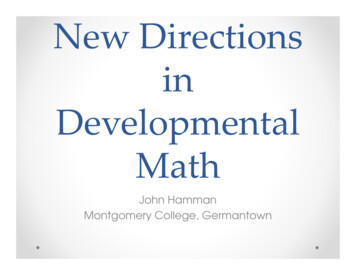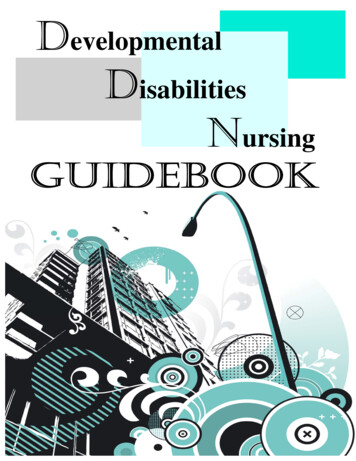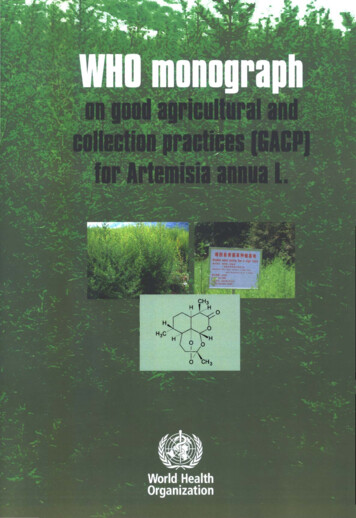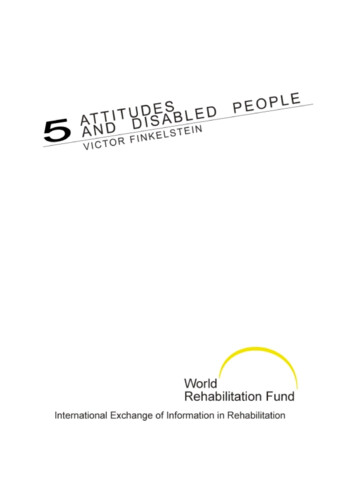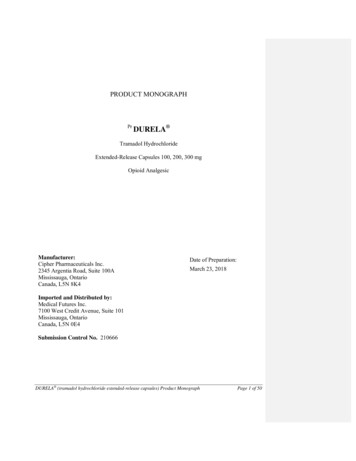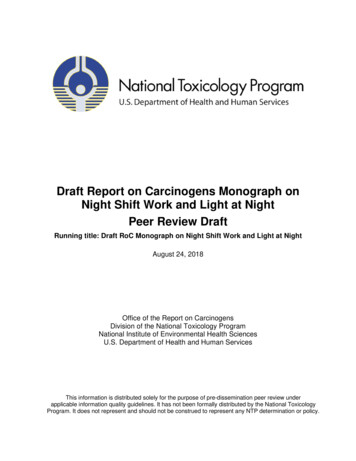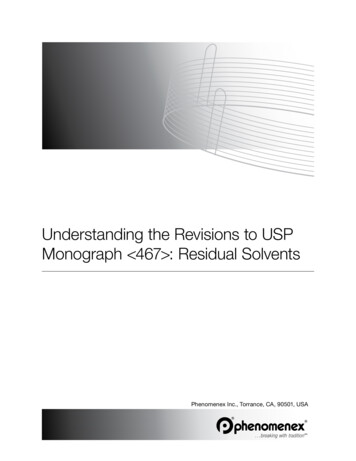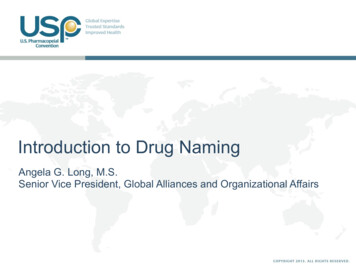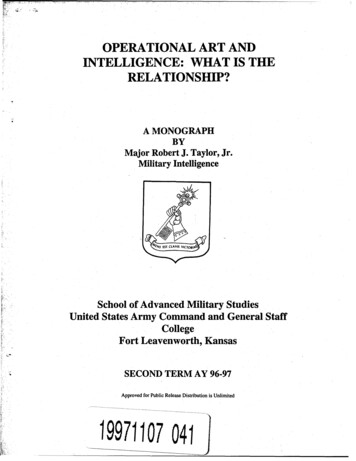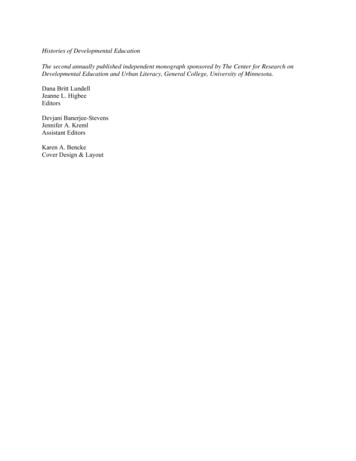
Transcription
Histories of Developmental EducationThe second annually published independent monograph sponsored by The Center for Research onDevelopmental Education and Urban Literacy, General College, University of Minnesota.Dana Britt LundellJeanne L. HigbeeEditorsDevjani Banerjee-StevensJennifer A. KremlAssistant EditorsKaren A. BenckeCover Design & Layout
Copyright 2002 by the Center for Research on Developmental Education and Urban Literacy, GeneralCollege, University of Minnesota, Minneapolis, MN.All rights reserved. No part of this publication may be reproduced, stored in a retrieval system, ortransmitted, in any form or by any means, electronic, mechanical, photocopying, recording, or otherwise,without prior written permission of the publisher.Printed in the United States of America.The University of Minnesota is committed to the policy that all persons shall have equal access to itsprograms, facilities, and employment without regard to race, color, creed, religion, national origin, sex,age, marital status, disability, public assistance status, veteran status, or sexual orientation.This publication/material can be made available in alternative formats for people with disabilities. Directrequests to Dana Lundell, General College, 333 Appleby Hall, 128 Pleasant Street SE, Minneapolis, MN,55455, 612-626-8706.Printed on recycled and recyclable paper with at least 10 percent postconsumer material.
ContentsForewordvTerence CollinsIntroduction 1Dana Britt Lundell and Jeanne L. HigbeeHistorical Perspectives: With Hindsight We Gain Foresight 3Norman StahlSupporting the Research Mission 7David V. TaylorA Brief History of the American Council of Developmental Education Associations11Hunter R. BoylanHistory of Supplemental Instruction (SI): Mainstreaming of Developmental Education15David ArendaleRecovering the Vision of John Dewey for Developmental Education 29Mary Ellen ShawHistory of Developmental Studies in Tennessee 35Carol Hopper Bader and Carlette Jackson HardinThe Conference on Basic Writing: 1980-2001Karen S. Uehling47Professional Status for Writing Center DirectorsMildred SteeleToward a Comprehensive Learning CenterMarti Singer5965The General College Base Curriculum: Description, Historical Antecedents,Theoretical Structure, and Evaluation Outcomes73Cathrine Wambach and Thomas BrothenThe Lessons of History: Transforming Science to Include Developmental Education83Randy Moore
Editorial BoardDavid ArendaleUniversity of Missouri-Kansas CityCarol BaderMiddle Tennessee State UniversityHunter BoylanAppalachian State UniversityThomas BrothenUniversity of MinnesotaMartha E. CasazzaNational-Louis UniversityCarl ChungUniversity of MinnesotaMary P .DemingGeorgia State UniversityIrene M. DuranczykEastern Michigan UniversityShevawn B. EatonNorthern Illinois UniversityPatricia A. MalinowskiFinger Lakes Community CollegeMichael O’HearIndiana-Purdue University,Norman A. StahlNorthern Illinois UniversityCheryl B. StrattonUniversity of GeorgiaDavid V.TaylorUniversity of MinnesotaLinda R. ThompsonHarding UniversityF ort Wayne
ForewordTerence Collins, Director of Academic AffairsGeneral College, University of MinnesotaThere are good reasons why the title of this monograph is set in the plural form “histories.” We whowork in developmental education work in plurals. We find our purposes grounded in divergent impulsesand in local decisions long forgotten, in specific institutional events, and in large national movements. Yetwe come together under the single banner of developmental education. As the histories captured heresuggest, that banner stretches uncomfortably to cover our many diverse purposes and our many localentities.If we take a long view, we see that developmental education traces its many roots to Reconstruction,to the Morrill Land Grant Act, to the Progressive Era, to the Workers’ Colleges of the Great Depression,to the G.I. Bill of Rights, to the Civil Rights Movement, to the Community College explosion of the latemid-Twentieth Century, and to the Open Admissions movement that followed hard upon these latterevents. We in developmental education are heirs to various moments of optimism about humanpossibility and the transformative possibilities of higher education. We and our students enact daily apeculiarly American optimism about human change and intellectual growth. These essays are importantin helping us remember where we find our origins and our momentum.I am especially proud that the General College (GC) of the University of Minnesota has collected andpublished this volume. In 1932, University President Lotus D. Coffman convinced his colleagues and theBoard of Regents that those students who were not prospering in the standard arts and sciencescurriculum had a legitimate place in the University. Under Malcolm Maclean and a group of visionarycolleagues, the General College forged and published “developmental” curricula grounded in the needs ofsuch students and informed by Dewey’s instrumentalist theories. The college continues this traditiontoday. During the Great Depression, the Land Grant promise of accessible higher learning and practicaleducation flourished in GC. Among those early students who could not pass the entrance test for theLiberal Arts college was Norman Borlaug, whose path through General College led him to the study ofplant genetics and the Nobel Peace Prize in 1970 as the “father of the Green Revolution.” In the yearsafter World War II, large numbers of war-weary young people entered the University under the G.I. Billof Rights. Many whose previous education had been interrupted by military service or by the demands ofthe war economy, like the esteemed Warren Spanaus, former Attorney General of Minnesota, and DaveMoore, award-winning newscaster and journalist, found their way into the University through GeneralCollege and emerged to shape post-war civic and business life in Minnesota. Like most colleges anduniversities, the University of Minnesota stretched in new directions to educate the diverse students whoentered higher education for the first time in the wake of the Civil Rights movement. General College andits faculty opened the University to new populations through flexible programs and new courses. ThroughUpward Bound, Student Support Services, and a radically ambitious student parent support program,students like Endesha Ida Mae Holland, Ph.D., Pulitzer nominated playwright and author, found theirvoice and their place in the University. Now, three decades later, GC remains the most ethnically vital anddiverse community on campus.Higher education is changing. Legislators and policy makers speak with alarm about the “epidemic ofremediation” and too often seek to put restrictions on access as the racial and social class divisions inAmerica widen. If we developmental educators wish to make telling arguments about our future, we willneed to know and build on our past. Volumes like this one can help us chart our way. We are in the debtof those whose work appears here.
IntroductionDana Britt Lundell, DirectorJeanne L. Higbee, Faculty ChairCenter for Research on Developmental Education and Urban LiteracyGeneral College, University of MinnesotaThe theme for this monograph arose from lively, productive conversations at the First IntentionalMeeting on Future Directions in Developmental Education, October 1999, in Minneapolis, Minnesota,sponsored by the Center for Research on Developmental Education and Urban Literacy and GeneralCollege at the University of Minnesota. Norman Stahl’s (2000) summary of one of the salient themesfrom this meeting, reprinted as the opening piece in this monograph, calls upon the field of researchersand practitioners in developmental education to articulate the field’s diverse histories and foundations as away to guide future practice, theory, and research. Stahl suggests examining the field’s past through avariety of lenses, including theoretical lenses, national and local policy issues, curricular and pedagogicaltrends, research frameworks, important individuals and students, and other items that mark the field’swork. The history is rich and highly diverse, and by making our work visible through documenting theseactivities, the field can strengthen its position as a leading force within higher education.Following up on that meeting’s theme, we have provided a forum in this monograph to promotehistorical discussions in the field. Specifically, we chose the plural form of this word—“histories”—as thetitle of this monograph to emphasize the highly varied foundations, locations, and activities that definedevelopmental education. This monograph is a collection reflecting a range of perspectives, includingcurricular histories, theoretical lenses, disciplinary foundations, local and national policy, andprofessional development. This collection provides a starting point for future conversations, and we hopeother individuals and program leaders will be inspired to continue this articulation.This volume begins with Stahl’s “Historical Perspectives: With Hindsight We Gain Foresight,”outlining the role of history in the field’s future. This is followed by an excerpt from a keynote addressgiven by Dean Taylor, General College-University of Minnesota, at the Third Annual ResearchConference in Developmental Education (October 24-28, 2001), in Charlotte, North Carolina, sponsoredby the National Center for Developmental Education (NCDE). This speech offers an administrativeperspective and observations from the vantage point of the General College’s history as one of the oldestdevelopmental education programs in the nation.In the next chapter, Boylan, Director of NCDE, offers “A Brief History of the ACDEAs—AmericanCouncil of Developmental Education Associations,” in which he explores the development and role of thecouncil’s leadership across organizations in the field. Arendale’s chapter presents the “History ofSupplemental Instruction (SI): Mainstreaming of Developmental Education,” offering a detailed accountof the development of SI programs across the nation. Shaw’s chapter provides yet another vantage pointfor the field, exploring an important theoretical lens for student development in “Recovering the Vision ofJohn Dewey for Developmental Education.” Together, these chapters highlight important pieces ofdevelopmental education’s increasingly strong national presence and rich political history.The next chapters shift toward a focus on programmatic and disciplinary histories, including Bader’sand Hardin’s “History of Developmental Studies in Tennessee,” which examines how evaluations andpolicy changes impact programs at the state level. Uehling’s chapter titled “The Conference on BasicWriting: 1980-2001” explores the growth of the basic writing profession as a strong developmentaleducation leader in the field of composition studies. Similarly, Steele’s chapter on “Professional Status forWriting Center Directors” documents a common theme in developmental education—the struggle forprofessional status. Singer also offers another take on this theme, documenting the lessons learned fromthe discontinuation of developmental education learning services in “Toward a Comprehensive Learning
Center.” In an examination of another program’s history, Wambach and Brothen offer “The GeneralCollege Base Curriculum: Description, Historical Antecedents, Theoretical Structure, and EvaluationOutcomes.” This is followed by Randy Moore’s focus on the impact of history in the field of scienceeducation, “The Lessons of History: Transforming Science to Include Developmental Education.” Thesechapters inspire us to continue to think about the ways developmental education has evolved as aprofession encompassing a diverse range of programs and services, and they encourage us to considerfuture directions for the field.For making this monograph possible, we want to express our thanks to Dean David Taylor andTerence Collins, Director of Academic Affairs, at the General College, University of Minnesota, forcontinuing to support the Center and its publications. Thanks also to our Editorial Board members, whosupported our work. Our fabulous editorial staff deserves much praise, including Jennifer Kreml andDevjani (Juni) Banerjee-Stevens (Assistant Editors), and Karen Bencke (technical support, layout, andcover design). We also thank all the authors who contributed to this monograph and believed in itspurpose.ReferencesStahl, N. (2000). Historical perspectives: With hindsight we gain foresight. In D. B. Lundell & J. L.Higbee (Eds.), Proceedings of the first intentional meeting on future directions in developmentaleducation (pp. 13–16). Minneapolis, MN: Center for Research on Developmental Education andUrban Literacy, General College, University of Minnesota.
Historical Perspectives: With Hindsight We Gain ForesightNorman StahlNorthern Illinois UniversityThis article is reprinted from the Proceedings of the First Intentional Meeting on Future Directions inDevelopmental Education, first published in 2001 by the Center for Research on DevelopmentalEducation and Urban Literacy, General College, University of Minnesota.The field of developmental education and learning assistance, along with its acknowledged subfieldsof college reading and study strategy instruction, basic composition instruction, and developmentalmathematics instruction, might best be described as a very young but old field. For so many of ourprograms, it has been less than a generation since they were birthed, and for so many or our colleagues, ithas been less than a decade since they began their service to the profession. On the other hand, the field ofdevelopmental education and learning assistance has a long and honorable history in service to thepostsecondary institutions of the nation (Boylan, 1988; Maxwell, 1997; Stahl & King, 2000).Hence, it is appropriate that we were called together in the waning days of the 20th century by theGeneral College with its own long history of involvement with nontraditional students. It is equallyappropriate that we met at the University of Minnesota, which has given so much to the field through theresearch, curriculum development, and important leadership of its faculty and staff such as Alton Raygor,Frances O. Triggs, Charles Bird, and David Wark. Their contributions form, in part, the history ofdevelopmental education and learning assistance.The Historical State of the ArtWe have a history to celebrate, but what have we done to preserve and to study our heritage? Clearlywe have come some distance in recent years in the development and the publication of a respectablecorpus of historical studies (Stahl & King, 2000). This history has been presented in a growing literaturebase composed of historical chronicles (e.g., Brier, 1983; Leedy, 1958), historical summaries andtimelines (e.g., Boylan, 1988; Boylan & White, 1987; Maxwell, 1997; Wyatt, 1992), and topical or eraoriented papers (e.g., Quinn, 1995; Stahl, King & Eilers, 1996; Stahl & Smith-Burke, 1999). Inreviewing the literature, one finds that broadly oriented sweeps of the historical landscape abound, butthere is still a limited number of historical works focused on individuals, institutions, curricularmovements, instructional innovations, and specific eras.As long-term participants in our field, we have come to value the historical perspective and torecognize its importance as our field strives to be recognized as a legitimate academic entity by ourcolleagues throughout the academy. We fully understand that the conduct of historical research should bemore than simply trying to fix one’s own place in history. Instead, we put forward a clarion call to allmembers of the field to undertake the continued examination of our roots and of our heroes from yearsgone by so that the legacy and the valued knowledge of the past two centuries can be shared withcolleagues and simply not fade away in the new millennium.Developmental Education Historyat the National and State LevelsIn advocating our position, we acknowledge that our history might be studied at two separate butnonetheless integrated levels: the national and state level, and the institution and program level. Let usexamine the former at this point. Throughout our discussions of the field’s history at the national level asit goes back into the 1800s, there were numerous questions raised that might guide future research.
Several examples can be put forward for the reader’s consideration at this point:1. Through what scholarly lenses (e.g., social history, critical pedagogy) have we or might weexamine our field’s history?2. How have the contributions from our field impacted the larger field of postsecondaryeducation over the decades? To what degree have we been either change agents or pawns in thelarger arena?3. How have the historical events and the curricular innovations and trends of postsecondaryeducation impacted our field over the years?4. What and how have governmental actions, economic policies and events, social issues, legalrulings, immigration trends, and general educational orientations and innovations influencedprograms?5. What have been the important programs and what were their particular contributions duringpast historical eras?6. Who have been the individuals who have influenced the field, and what have been eachindividual’s key contributions?7. What were the landmark scholarly texts, assessment devices, and curricular materials acrossthe years, and why did these texts gain such status?Questions pertaining to our past such as the aforementioned are among many requiring initial orcontinued scrutiny by the research community. In addition, clear consideration should be given to suchquestions by graduate students as they look for original and scholarly topics for either their thesis or theirdissertation research.Developmental Education Historyat the Nearby LevelLet us now turn to a more localized or nearby form of historical endeavor for the developmentaleducator and the learning assistance professional. It is unfortunate that the orientation to history so manyof us encountered in school taught us to value a cult of facts associated with great men, just wars, andmomentous movements of the premodern and modern eras. All the while we overlooked the morepersonal and, ever so often, more relevant facets of nearby history. (See Kyvig & Marty, 1982, for indepth coverage of many of the ideas underlying the practice of nearby history.) Indeed, as WilliamShakespeare penned, there is history in all men’s lives.Clearly developmental educators must be ever cognizant that history is not the sole province ofnational and international events. If historical events and sociopolitical movements of the past twocenturies have shaped the developmental education profession of 2000, so too has the impact of each beenfelt at the program, the institution, and the system levels. Furthermore, important history has been madewithin these organizations as well.The five of us are in strong concordance that our colleagues within the developmental education andthe learning assistance professions must place value on and then undertake the chronicling and celebratingof the roots of our respective programs whether these be at universities, liberal arts colleges, communitycolleges, or technical colleges. It is so true that the profession has much to gain by learning about ourrespective programs’ origins, milestones, dynamics, and effective leaders. The profession has much to
learn from how particular programs faced and overcame adversity brought by academic forces internal tothe institution or the higher education system, or by sociopolitical forces playing themselves out at thestate or national levels. The profession has much to gain by embracing and promoting the practice ofnearby history as a valued scholarly activity for the program, the institution, and the field ofdevelopmental education.It is with the study of nearby history, whether through the review of published documents andunpublished sources, the examination of artifacts, or the conduct of oral histories, that we can answerquestions such as the following:1. Who are we as developmental educators, as members of our profession, and as members ofour academic communities?2. How have our programs evolved over the years to become what they are today?3. How have we been able to contend with the various situations, both internal and external tothe program, that have been encountered over the years of program operation?4. What can we expect from people, programs, and policies that impact our professional lives?5. How might we use historical lessons at one’s campus and from other schools to predict andplan for the future?It is through the conduct of nearby history (for examples see Spann, 1996, and Walker, 1980) that weare able to build a professional community and a professional identity, all the while being able tocelebrate the distinctiveness of each of our programs.History in Our FutureWhere we have failed, and we might say failed rather dramatically, is in the promotion of thehistorical perspective to those individuals serving in developmental education or learning assistancepositions. National accreditation boards and state certification agencies require that all prospectiveteachers from preschool through the 12th grade demonstrate knowledge of the historical foundations ofeducation. Individuals seeking advanced degrees in higher education are required generally to completecourse work pertaining to the history of higher education. Our colleagues in developmental education donot have at this time formal accreditation agency mandates, and only in rare circumstances do they meetwith institutional mandates requiring knowledge of the history of our field.Because developmental educators and learning assistance specialists are more often than not selftrained in the field, few individuals have had the opportunity to learn about and hence to value our field’srich heritage. Formal degree programs and certificate programs such as those offered by AppalachianState University, Grambling State University, Southwest Texas State University, and National LouisUniversity are limited. Graduate courses like those found at Northern Illinois University and theUniversity of Georgia that cover our history are not prevalent. It is little surprise, then, that werecommend that existing training programs direct attention to the historical foundation for the fieldthrough course objectives and degree requirements. In addition, we believe that through distanceeducation and on-line courses there will be boundless opportunities for quality instruction about our fieldto be delivered to individuals not able to attend more traditional venues. In the future as this becomes thecase, any courses or programs that make use of nontraditional delivery systems should include historicalcoverage of the field.Presentations on the field’s history continue to be quite limited at conferences and symposia such as
those put on by the National Association for Developmental Education (NADE), the National Center forDevelopmental Education (NCDE), and the College Reading and Learning Association (CRLA).Unfortunately, when historical topics are available, the sessions tend to be attended poorly as individualsare more often than not seeking sessions providing guidance and best practice for the day-to-day concernsof the developmental educator. Hence, we voice a shared opinion that our national and state professionalassociations as well as those institutions delivering conferences and institutes should strive to foster thestudy of our history and the dissemination of such endeavors. Those organizations that do not have ahistorian on the board of directors, should appoint an individual to such a position. Those organizationsthat have an individual or committee charged with promoting the historical perspective of theorganization and of the field should develop a formal plan by which the celebration of our history is anongoing activity through the development of historical narratives and oral history projects.We close this paper with a feeling that we all took away with us from our conversations. It is time forour colleagues to become students of our history. It is time for our colleagues to value our historicalcontributions to postsecondary education. It is time for our colleagues to become historians of our fieldboth at the national and nearby levels. It is time for the leadership of the field to have the conviction tosupport research and activities delving into our honored heritage. Finally, it is time for all of us to realizethat through informed hindsight we gain the foresight necessary to move the field forward in this newmillennium.ReferencesBoylan, H. R. (1988). The historical roots of developmental education. Research in DevelopmentalEducation, 5(3), 1-4.Boylan, H. R., & White, W. G. (1987). Educating all the nation’s people: The historical roots ofdevelopmental education. Research in Developmental Education, 4(4), 1-4.Brier, E. (1983). Bridging the academic preparation gap at Vassar College and Cornell University,1865-1890. Unpublished doctoral dissertation, Columbia University Teachers College, New York.(University Microfilms #8322180)Kyvig, D. E., & Marty, M. A. (1982). Nearby history. Nashville, TN: American Association for State andLocal History.Leedy, P. D. (1958). A history of the origin and development of instruction in reading improvement atthe college level. Unpublished doctoral dissertation, New York University, New York. (UniversityMicrofilms #59-01016)Maxwell, M. (1997). Improving student learning skills: A new edition. Clearwater, FL: H&H.Quinn, K. B. (1995). Teaching reading and writing as modes of learning in college: A glance at the past;A view to the future. Reading Research and Instruction, 34(4), 295-314.Spann, M. G. (1996). National Center of Developmental Education: The formative years. Journal ofDevelopmental Education, 20(2), 2-6.Stahl, N. A., & King, J. R. (2000). A history of college reading. In R. F. Flippo & D. C. Caverly (Eds.),Handbook of college reading and study strategy research (pp. 1-23). Mahwah, NJ: Erlbaum.Stahl, N. A., King, J. R., & Eilers, U. (1996). Postsecondary reading strategies: Rediscovered. Journal ofAdolescent and Adult Literacy, 39(5), 368-379.
Stahl, N. A., & Smith-Burke, M. T. (1999). The National Reading Conference: The college and adultreading years. Journal of Literacy Research, 31(1), 47- 66.Walker, M. M. J. (1980). The reading and study skills program at Northern Illinois University, 19631976. An unpublished doctoral dissertation, Northern Illinois University, DeKalb, IL. DissertationAbstracts International, 41(03A), 929. (University Microfilms No. 80-20783.)Wyatt M. (1992). The past, present, and future need for college reading courses in the U.S. Journal ofReading, 36(1), 10-20.
Supporting the Research MissionDavid V . Taylor, DeanGeneral College, University of MinnesotaThis article is an excerpt from a keynote address presented at the National Center for DevelopmentalEducation’s Third National Conference on Research in Developmental Education, Charlotte, NorthCarolina, on October 25, 2001, by Dr. David V. Taylor, Dean of the General College, University ofMinnesota.It is indeed a pleasure to have been invited to attend this conference, the Third National Conferenceon Research in Developmental Education. I am especially pleased to have been given an opportunity toaddress this exceptional group of educators and to share with you some observations that I have made asan administrator of an academic unit whose expressed mission is to promote the discipline ofdevelopmental education through research and teaching.The title of my presentation is “Supporting the Research Mission.” However, after someconsideration I thought that I would initially share with you today a small piece of the General Collegepast. This is necessary in order to place in proper context my understanding of what it takes to support aresearch mission.Although the current president of the University of Minnesota refers to the college as one of thejewels in the University’s crown, we have been not so favorably considered over the years of the college’sexistence. It has been a 70 year struggle for legitimacy and recognition. In the experiences that I am aboutto share, perhaps many of you might identify some similarities between our struggle and yourexperiences.The General College was founded in 1932 as an experimental approach to a retention problemexperienced by the University of Minnesota. Once admitted to the University, students were thrown into avery traditional liberal arts curriculum with no introduction to core disciplines or assistance indetermining a major field of study. Under these circumstances and without effective counseling, studentsdropped out of the University early in their studies. Very concerned about a serious retention problem,President Lotus Coffman approved two experimental programs. The first was called University College,an interdisciplinary program founded in 1931 that culminated in an individualized major. The second wasthe General College, founded in 1932, a program offering a general education curriculum featuringintroductory courses to the core disciplines and academic and personal counseling for students. During itsfirst 25 years it became nationally known for its curriculum and student services advising and counselingprogram. By the late 1970s the General College offered certificate programs, Associate of Arts degrees,and two baccalaureate degree programs.At the time of my appointment in 1989, the General College was under duress. Over several decadesthe University had added several new degree programs without eliminating any. State funding had notkept pace with programmatic expansion. During the intervening years the State of Minnesota had alsoe
College and emerged to shape post-war civic and business life in Minnesota. Like most colleges and universities, the University of Minnesota stretched in new directions to educate the diverse students who entered higher education for the first time in the wake of the Civil Rights movement. General College and
